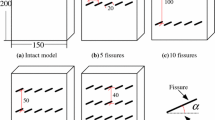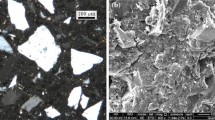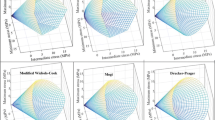Abstract
Particle flow code (PFC2D) software was adopted to investigate the anchorage behaviour and the characteristics of crack initiation, propagation and coalescence of reinforced specimens containing a single fissure (RSCSF). The microscopic parameters of the specimens in the numerical simulation were first validated by experimental outcomes of intact specimens, while the microscopic parameters of the rock bolts were validated based on the results of the RSCSF tests. Then, the mechanical parameters as well as the failure modes in the physical experiments were compared with those derived by the numerical simulation; the results showed good agreement between the simulated macroscopic mechanical properties and failure modes and those obtained in the laboratory experiments. The peak strength, number of cracks and the failure mode varied considerably as the anchorage angle α and fissure angle β increased. Three types of stress–strain curves, types I to III, were obtained from the RSCSF. Shear cracks were observed for all three categories of curves, but the tensile cracks were dominant. The number of cracks and the rate of bond failures decreased as the curve changed from type II to type I to type III. RSCSF failure can be classified into three failure modes: (1) tip crack propagation mode, (2) midpoint crack propagation mode and (3) rock bolt crack propagation mode. These failure modes are primarily differentiated by relations between α and β, and the ratio UCSS/UCSI between the uniaxial compressive strength (UCS, σ max) of the RSCSF (UCSS) and the uniaxial compressive strength of the intact specimen (UCSI).




















Similar content being viewed by others
Abbreviations
- E n , E s :
-
Normal and shear stiffness
- σ n , τ s :
-
Normal and shear stress
- u n , u s :
-
Normal and shear displacement
- σ max :
-
Uniaxial compressive strength (UCS)
- τ max :
-
Shear strength
- \( {\sigma}_r^T \) :
-
Residual tensile strength
- c :
-
Cohesive strength
- c r :
-
Residual cohesive strength
- ϕ :
-
Friction angle
- ϕ r :
-
Residual friction angle
- △u s :
-
Incremental contact shear displacement
- α :
-
Anchorage angle
- β :
-
Fissure angle
- N :
-
The total number of cracks
- N t :
-
The number of tensile cracks
- N s :
-
The number of shear cracks
- ε max :
-
Peak axial strain
- E slope :
-
The elastic modulus refers to the slope
- UCSS :
-
the UCS of the RSCSF
- UCSI :
-
the UCS of the intact specimen
References
Aoki K, Mito Y, Mori T, Morioka H, Maejima T (2004) Evaluation of behavior of EDZ around rock cavern by AE measurements and DEM simulation using bonded particle model. In: Ohnishi Y, Aoki K (eds) pp 327–333
Bombolakis E, Brace W (1963) A note on brittle crack growth in compression. J Geophys Res 68:3709–3713
Boscato G, Russo S (2013) Free vibrations of a pultruded GFRP frame with different rotational stiffnesses of bolted joints. Mech Compos Mater 48:655–668
Brady BH, Brown ET (2011) Rock mechanics for underground mining. Science Press
Cao R, Cao P, Lin H, Pu C, Ou K (2016) Mechanical behavior of brittle rock-like specimens with pre-existing fissures under uniaxial loading: experimental studies and particle mechanics approach. Rock Mech Rock Eng 49:763–783
Chen W, Konietzky H (2014) Simulation of heterogeneity, creep, damage and lifetime for loaded brittle rocks. Tectonophysics 633:164–175
Cho N, Martin CD, Sego DC (2007) A clumped particle model for rock. Int J Rock Mech Min 44:997–1010
Coggan J, Gao F, Stead D, Elmo D (2012) Numerical modelling of the effects of weak immediate roof lithology on coal mine roadway stability. Int J Coal Geol 90:100–109
Goodman RE, Taylor RL, Brekke TL (1968) A model for the mechanics of jointed rock. Journal of Soil Mechanics & Foundations Div 94(3):637–660
Haeri H, Shahriar K, Marji MF, Moarefvand P (2014) On the strength and crack propagation process of the pre-cracked rock-like specimens under uniaxial compression (vol 46, pg 140, 2014). Strength Mater+ 46:301
Heuze FE (1980) Scale effects in the determination of rock mass strength and deformability. Rock Mech 12:167–192
Hoek E, Bieniawski Z (1984) Brittle fracture propagation in rock under compression. Int J Fracture 26:276–294
Itasca Consulting Group I (2014) PFC2D manual, version 5.0. Minnesota, Minneapolis
Lee H, Jeon S (2011) An experimental and numerical study of fracture coalescence in pre-cracked specimens under uniaxial compression. Int J Solids Struct 48:979–999
Manouchehrian A, Marji MF (2012) Numerical analysis of confinement effect on crack propagation mechanism from a flaw in a pre-cracked rock under compression. Acta Mech Sinica-Prc 28:1389–1397
Manouchehrian A, Sharifzadeh M, Marji MF, Gholamnejad J (2014) A bonded particle model for analysis of the flaw orientation effect on crack propagation mechanism in brittle materials under compression. Arch Civ Mech Eng 14:40–52
Park CH, Bobet A (2010) Crack initiation, propagation and coalescence from frictional flaws in uniaxial compression. Eng Fract Mech 77:2727–2748
Potyondy DO, Cundall PA (2004) A bonded-particle model for rock. Int J Rock Mech Min 41:1329–1364
Pu C, Cao P (2012) Failure characteristics and its influencing factors of rock-like material with multi-fissures under uniaxial compression. T Nonferr Metal Soc 22:185–191
Sagong M, Bobet A (2002) Coalescence of multiple flaws in a rock-model material in uniaxial compression. Int J Rock Mech Min 39:229–241
Tang CA, Liu H, Lee P, Tsui Y, Tham LG (2000a) Numerical studies of the influence of microstructure on rock failure in uniaxial compression—part I: effect of heterogeneity. Int J Rock Mech Min 37:555–569
Tang CA, Tham LG, Lee P, Tsui Y, Liu H (2000b) Numerical studies of the influence of microstructure on rock failure in uniaxial compression—part II: constraint, slenderness and size effect. Int J Rock Mech Min 37:571–583
Wang C, Xu J, Zhao X, Wei M (2012) Fractal characteristics and its application in electromagnetic radiation signals during fracturing of coal or rock. Int J Min Sci Technol 22:255–258
Wong RH, Chau K (1998) Crack coalescence in a rock-like material containing two cracks. Int J Rock Mech Min 35:147–164
Wu Z, Wong LNY (2013) Modeling cracking behavior of rock mass containing inclusions using the enriched numerical manifold method. Eng Geol 162:1–13
Xie S, Li E, Li S, Wang J, He C, Yang Y (2015) Surrounding rock control mechanism of deep coal roadways and its application. Int J Min Sci Technol 25:429–434
Xu Y, Dai F, Xu NW, Zhao T (2016) Numerical investigation of dynamic rock fracture toughness determination using a semi-circular bend specimen in split Hopkinson pressure bar testing. Rock Mech Rock Eng 49:731–745
Yang M, Zhao Y, Zhang N (2014a) Creep behavior of epoxy-bonded anchor system. Int J Rock Mech Min 67:96–103
Yang S, Huang Y, Jing H, Liu X (2014b) Discrete element modeling on fracture coalescence behavior of red sandstone containing two unparallel fissures under uniaxial compression. Eng Geol 178:28–48
Yang S, Huang Y, Ranjith PG, Jiao Y, Ji J (2015) Discrete element modeling on the crack evolution behavior of brittle sandstone containing three fissures under uniaxial compression. Acta Mech Sinica-Prc 31:871–889
Yang S, Tian W, Huang Y, Ranjith P, Ju Y (2016) An experimental and numerical study on cracking behavior of brittle sandstone containing two non-coplanar fissures under uniaxial compression. Rock Mech Rock Eng 49(4):1497–1515
Zhang N, Li S, Li M, Lv A (2011) Experimental study of reinforced effect of bolt in 3D surface fractured specimens under uniaxial compression. Rock and Soil Mechanic 32:3289–3294 in Chinese and abstract in English
Zhang X, Wong LNY (2013) Crack initiation, propagation and coalescence in rock-like material containing two flaws: a numerical study based on bonded-particle model approach. Rock Mech Rock Eng 46:1001–1021
Acknowledgments
This work was supported by the National Natural Science Foundation of China (NSFC, Grant Nos: 51474208), the Fundamental Research Funds for the Central Universities (Grant Nos: 2014XT01), the Project Funded by the Priority Academic Program Development of Jiangsu Higher Education Institutions (Grant Nos: PAPD), Graduate Students of Jiangsu Province Innovation Program (Grant Nos: KYLX_1404) and CUMT Innovation and Entrepreneurship Fund for Undergraduates (Grant Nos: 201504).
Author information
Authors and Affiliations
Corresponding author
Rights and permissions
About this article
Cite this article
Chong, Z., Li, X., Yao, Q. et al. Anchorage behaviour of reinforced specimens containing a single fissure under uniaxial loading: a particle mechanics approach. Arab J Geosci 9, 592 (2016). https://doi.org/10.1007/s12517-016-2618-0
Received:
Accepted:
Published:
DOI: https://doi.org/10.1007/s12517-016-2618-0




